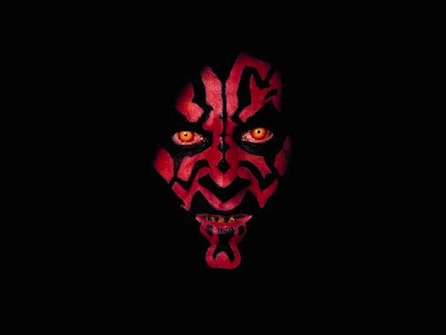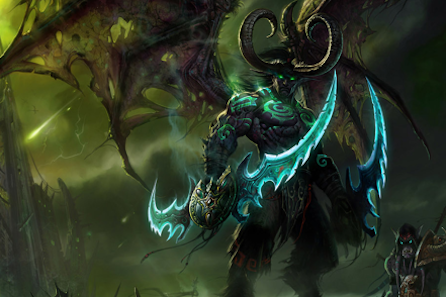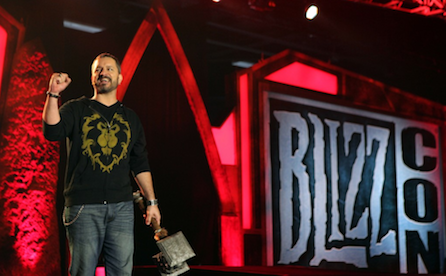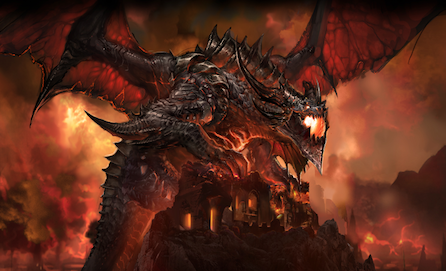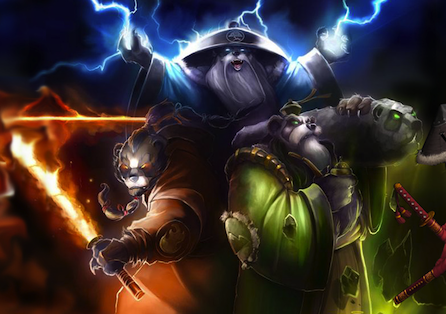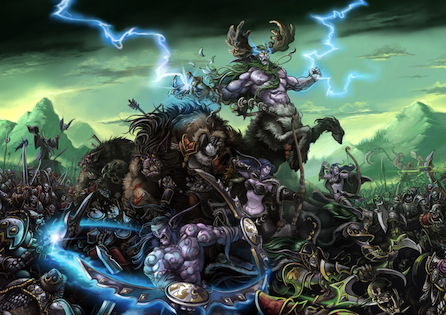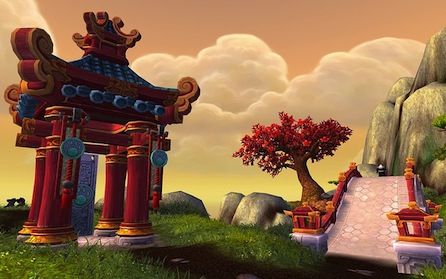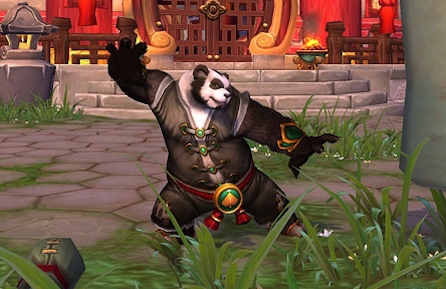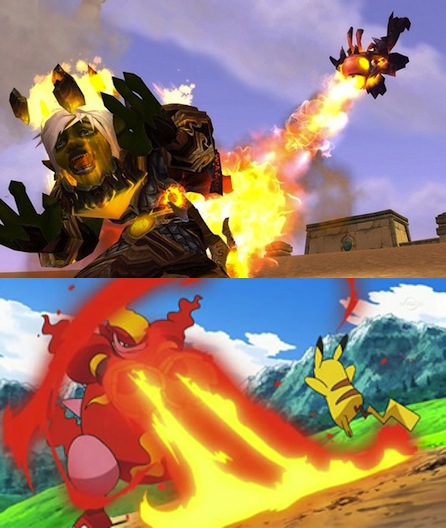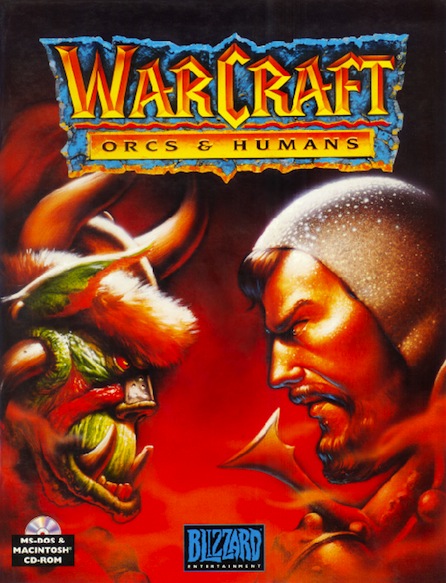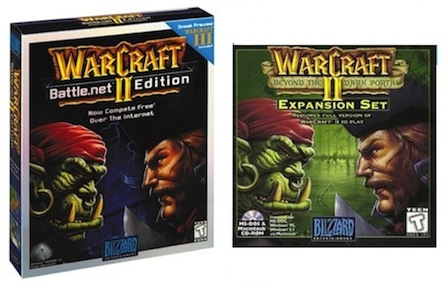Manchu WoW: Pandaria, 5.0, and Where World of Warcraft is Now
Did you look as confused as I and my friend Kiki here did when Blizzard unveiled World of Warcraft‘s fourth expansion at Blizzcon last month?
Blizzard’s golden child is going into its eighth year, and Mists of Pandaria is the game’s early, bi-curious, bipolar adolescence, rife with identity crises and plenty of confusion about its future and its present.
Pandaria and the future of WoW, however, have real, hidden meat (#unnecessary) that the average or even relatively-savvy player can’t see unless they frequent Blizzard news posts or community chat.
Unless you’re an insane WoW addict like me or my kind, you don’t do that and can’t be expected to; your barometer on the wildly successful MMO is whatever Blizzard’s handsome devil of a mouthpiece (and resident head of creative, Chris Metzen) dishes out every year on stage to a convention hall packed with nerds, later carved into bite-size youtube clips.
So what’d we get this year?
Bamboo-stic, panda-rife, Asian-stir-fried nonsense in place of a genuine, thrilling tease for a new expansion, one that’s been conceptualized and billed as a return to almighty WAR in a game that’s largely been lacking it for years.
The reveal smacked of something less timely than Blizzard’s usual spectacles. It almost seemed like the company — which, let’s get real, has just about the greatest track record in game development, ever? — was unaware that its greatest threat is coming on December 20th of this very year.
Why would Blizzard answer the threat of Jedi, Sith, the motherfucking Force, the unstoppable juggernaut of lore and presence that is the Star Wars universe…with pandas? And an Asian motif that seems dimensionally anachronistic for a Blizzard property? And…no sinister villain in sight?
You’re also asking and thinking right now: Why all this fuss over an expansion set, Budrickton?
World of Warcraft evolves multiple times a year. It’s an absolute BEAST of game development and reiteration, changing all the time to respond to new development trends, player suggestions and outcry, and at its best moments, to believably further the massive history and lore of the Warcraft universe.
In the best of those ‘best’ moments, the game also creates gameplay systems that manage to synergistically work with and reflect that lore in surprisingly awesome ways.
For game development nerds like me that are fascinated by the process, there is no better textbook reference than watching WoW evolve since 2004.
As the current and likely perma-reigning king of the MMO genre, a game type that mandates iteration and reiteration to continually foster interest and subscriber retention, WoW is probably the largest game project in the world that faces continual, transformative reshaping year after year.
That’s a fairly rational assumption I’m making based on my experience and knowledge of the industry, and I’d be surprised to learn I’m wrong.
Expansions are chapter headings, the biggest of these updates, and a valuable way to examine where the overall game is now, where it’s been, and what’s coming. Pandaria’s muddled and disappointing reveal was therefore, not immediately indicative of a healthy future for WoW. At least, not on the surface.
Context is everything, though…right? Join me here a second.
Thursday, Day 1 of Blizzcon. Chris Metzen, Blizzard’s own Mouth of Sauron, takes the stage at the opening ceremony. Dude annually treats with fans to spur them into a frenzied pack of animals ready to deep-throat whatever big ol’ Blue was doling out.
On the heels of a nightmarish and truly slick Diablo III cinematic reveal, then the showcase of a new Blizzard property in DOTA, and penultimately, the first real look at Starcraft II’s next chapter, Heart of the Swarm, there had to be something amazing to wrap the ceremony. A new expansion for Blizzard’s best-loved child had to be the most engaging and thrilling closer possible for Metzen’s presentation.
Adding to the pressure: the Warcraft universe has seen its most storied and spectacular villains unleashed and unhorsed over the last five years, and Blizzard gave players front row seats from every preview to every final endgame raid.
Remember these fun treats?
Burning Crusade: Visiting what amounted to another planet in the WoW-verse to hunt down demon hunter and persistent Warcraft antagonist, Illidan, then resisting demonic invasions past and present captained by the ‘devil’s own lieutenants, Archimonde and Kil’jaeden.
Wrath of the Lich King: Assaulting the third, enormous and untouched continent of the world to crack Azeroth’s history wide open, raid the vaults of the world-shaping Titans, vanquish an Old God, and ultimately bring down a villain teased at for seven years in Arthas, the eponymous Lich King himself.
Cataclysm: Launching into the skies of a completely broken and reformed world to take down Deathwing, the motherfucking devil-lord of all dragons, who shattered the crust of the planet when he woke up grumpy from a nap.
That’s what Mists of Pandaria had to follow.
Double the pressure you say?
Wrath and Cataclysm were systematically deconstructed, their myriad of story elements and gameplay designs peeled away and laid bare weeks before officially being revealed in a manner only iPhone spec leaks could rival. Pandaria? Save for its title made known by trademark, no one knew a thing about this expansion.
Triple the pressure? Why the fuck not.
Bioware’s Star Wars: The Old Republic is coming this winter, and represents the single greatest threat WoW’s ever known in the MMO sphere. This seemed like the best time to unveil something transformative and critically engaging to keep attention on Blizzard’s favorite child and subscription money flowing into Blue’s coffers.
Another cataclysm, if they so dared.
Bring it on! Right?
Minute One: Blizzard takes its time to remind us of where WoW has been, before unleashing endangered oriental mammals on Azeroth. Which in retrospect is like contextualizing Kung Fu Panda by couching it as a chapter within The Lord of the Rings.
Minute The Rest: The soundtrack to Crouching Tiger, Hidden Dragon plays, an unmistakable sweet teriyaki sauce coats your eyes, and let’s face it, all your senses, from a decidedly Japanese-inspired scrawl on building signs to the cherry blossom trees peppering the synthesized Pandarian landscape (admittedly beautifully-rendered in such an aged game engine).
And then, a panda drops out of the sky.
There’s an army of them. A whole country of them, kept secret in the ‘mists’. The cute motherfuckers belt out some punches, kicks and tiger crane stances to the announcement of a new Monk class. Only it doesn’t come nearly as well-characterized and situated to the game’s current conflict as Death Knights did two expansions ago.
All most people can think as they watch this is, how did Dreamworks and Jack Black get into my fantasy RPG, and why isn’t there a bad guy whose dictatorial ass I’m supposed to annihilate? Why am I not as thrilled as I am at everything else Blizzard has shown me?
It was a shaky, questionable look at WoW‘s future; but also understand, this expansion’s core elements weren’t so poorly chosen. Here’s why.
Pandaren started out as a something of a joke in Warcraft III way back in 2002. Blizzard’s never been a stranger to letting pop culture references and a sense of whimsy into their game universes. The notion of wandering Panda Brewmasters in a world otherwise fashioning itself after a more fantastical Middle-Earth is pretty rocking. Their place in the periphery of Azeroth was always welcome.
Including the drunken brewmasters as a playable race in World of Warcraft isn’t a stretch at all, either. Where do you go after 12 playable races, rather than one of the most popular and requested Warcraft races of all? Players apparently wanted this in droves, and Metzen even let on that they were planned as a playable race for the Burning Crusade back in 2007.
Metzen also lets on vis-Ã -vis his gruff and ubiquitous (yet ever so sexy) voiceover in the trailer, that what’s coming for Azeroth, is war. Real war. Not twenty-five basement-dwellers ganging up on one tyrannical, shit-stirring overlord, but the return to all-out conflict between the two factions of Warcraft.
So here’s the question: Where the fuck was all of this in Pandaria‘s debut? The narrative at work for this expansion is all about war ruining the pandas’ good time and overall ‘oriental tranquility’ (basically trademarked, given the infuriating intensity of this theme in all Pandaria media). It smacks of some kind of eco-disaster tale that I couldn’t care less about as a player.
If we’re going to end the world’s villains and return to true war between Warcraft’s iconic two factions, I want to see the Alliance and the Horde clash head-on, diplomatically and war-omatically, and see how that theme affects gameplay.
The notion of dragging a neutral and peace-loving people into a larger war is rote, but rings true — in a world infested with violent humanoid animals like Warcraft’s, ‘war coming to their shores’ is the perfect excuse to bring a new playable race into the larger conflict. This was accomplished with marvelous aplomb in Cataclysm with the introduction of Worgen and Goblins, but a bunch of enlightened pandas that don’t look the least bit threatened doesn’t seem to cut it.
Add in new game elements that didn’t get the right introduction or explanation, no matter how welcome they’d be in the current WoW landscape — ‘Challenge Mode Dungeons’ and ‘PvE Scenarios’, a ‘Pet Battle System’ that sounds incontrovertibly like a transplanted Pokémon minigame, a Monk class that has neither the surface spice nor the contextual cohesion with the overall narrative that Death Knights brought to the table, and the lack of a villain to fear or fight — and what are you left with?
A remarkably cluttered construction of an expansion, Jenga-esque in its holes and shaky foundation, and in desperate need of continued work and reiteration to make sense of the larger package. This wasn’t the right time for an ambivalent future look at WoW, not with subscriptions lapsing and Star Wars ready to go for the jugular.
I’m here to make you believe in Blizzard again though, even if they couldn’t package the deal right themselves. If you cut through the lapse in marketing sense here, you find that there’s a great deal of shine under the hood with Pandaria and WoW “5.0”, even if the name of the expansion is the first problem with the whole endeavour to begin with.
A whole new continent is waiting in Pandaria for players to explore and raid. What sounded like a great idea on paper in the reshaping of the world for Cataclysm has left a sour taste in fans’ mouths; five new zones scattered around the existing world can’t have the same impact that a whole new continent can. Pandaria (if you can ever shake that ludicrous name) is going to get that approach right again.
The game’s talent and ability system, the core means by which a player differentiates and evolves their character’s abilities is receiving a dramatic transformation that makes past overhauls look like afterthoughts. The change is overdue and sure to create the greatest amount of flexibility and differentiation among players of the same class, something sorely lacking in the game for years.
Challenge Mode dungeons, once explained, are a return to the time attack inspired by the Zul’Aman bear mount runs of 2008, what I’m going to say was Blizzard’s finest moment in WoW raid design over the last six years. The best players will be tasked to complete dungeons with speed, emphasizing class synergy, group construction and on-the-fly strategizing — in short, everything that made the ZA runs so well-tuned and exciting.
Taking things a step further, Blizzard’s introducing gear normalization for these challenges. It’ll be impossible to outgear and brute-force the objectives by face-rolling your way to strong rewards elsewhere, only to trivialize these challenges and claim a timed run you didn’t earn with pure skill. It’s a phenomenal idea and will only support the devs’ abilities to tune the runs to perfection.
Monks, also, once explained, turn out to be exactly what WoW needed in a new class; one more option to fit the still-lacking tank and healer roles, a unique set of weapon choices in polearms, staves and fist-weapons, and a class that has no auto-attack function for the first time.
This works perfectly with Blizzard’s Cataclysm philosophy of making sure a player is doing something at all times instead of mashing one win-button. They reinforced that design by introducing new abilities for all classes that encouraged cross-use of skills, using auras to alert players to opportunities they might have been missing, and stifling the notion of spam-to-win design for new encounters. A new class that requires constant input for results is a full commitment to that philosophy, and welcome in a game that so often gets criticized for being a spam-heavy grind-fest.
That Monks will utilize a new resource system of Chi that works with Light and Dark forces is amusing with The Old Republic coming this winter. Our new Pandaren race will also have an early-game choice of joining either the Alliance or the Horde, as well. Surely there are nods to Star Wars in here somewhere, even if the moralistic system of previous Star Wars titles is mercifully absent from Pandaria.
The pet battle system, albeit a hilarious transplant from an unnamed Nintendo franchise is another infusion of exactly what WoW needs; diversions, activities and opportunities for player growth outside the often-impenetrable core raiding structure of the game. WoW’s had that shit before, but it’s been interminably boring (fishing virtual waters that amount to games of pure chance) or intangibly unsatisfying (achievements grant a motherlode of things to do, but 99% of them offer no reward, save useless points and a shiny declaration at the bottom of your screen).
We’ll forgive the obscene design lift from Nintendo in order to introduce the phenomenon of meaningful collecting into WoW.
Collecting is a powerful motivator in gaming. Pokémon — oh shit, I said it — love it or leave it, is a veritable juggernaut in gaming built on the ripe OCD-ist mentality of needing to catch ‘em all, a simple and addictive design. Collecting something you can see and use, instead of ethereal and inconsequential achievement points is a truly powerful lure when convincing nerds to throw down $15 a month.
And finally, when Metzen and his team of blue braves throw down the lore and tell us that the expansion will, patch by patch, reintroduce and continually escalate the war between the Alliance and the Horde, I can’t help but get a nerdy chubby.
After all, just LOOK at the covers to every original Warcraft game. What do you see?
Factions facing each other, head-on. It’s what Warcraft used to be all about. Knowing that that theme will be featured centre-stage again in the core story of the series is exciting.
Blizzard’s challenge is going to be putting a face on that overall antagonism. Ask yourself why so many trailers work, particularly game trailers, and most especially, Blizzard’s.
BAD DUDES. Gumming up the hero’s good times.
You’ve got Diablo himself invading your nightmares, Kerrigan taunting you from across space, and Deathwing shattering the world and blotting out the motherfucking sun. Not having a central antagonist to taunt players at Pandaria’s outset is a brave, but clumsy direction to take in a series where powerful villains were always the real motivators to gear up and play.
Again, there’s a queer and confused intelligence at work here. Most of the pieces to the larger puzzle are on the board. They’re just assembled for complete shit, and Blizzard needs to show people just how much the game’s changed and improved for the better.
I find my attitude and the attitudes of the player base at large are just as bipolar and confused as Pandaria comes off as being. I look back on this wall of text and find myself torn between bashing an expansion that’s taken what used to be an actual April Fools’ Joke for a title, and wanting to lavish every praise on it for emblematizing WoW‘s dramatic and positive overhaul since 2010.
WoW has irrefutably become the most accessible MMORPG in history (for better or for worse) while still maintaining an enticing and beautifully realized fantasy world and history. With subscriptions finally peaking and actually declining for the first time in 2010 and 2011, and Bioware’s beast hitting shelves in under two months, Pandaria needs to be a lot more for Warcraft than a cute diversion; it needs to remind players why the series has been the champion of its kind for seven years, and why it deserves to be for several more to come.
Credit: VG247 – Chris Metzen/Blizzcon 2011 photo.





